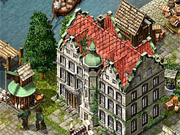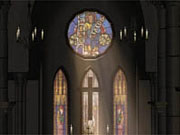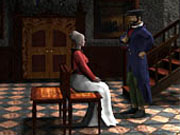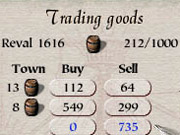In the 14th century, German merchants dominated trade throughout Northern Europe, thanks to trade concessions granted to the Hanseatic League. At a time when sea routes in the Baltic and Mediterranean carried the vast bulk of goods and raw materials across Europe, it was possible for fortunate long-distance merchants to earn great fortunes and rise to positions of significant local power. Patrician II is a game that gives you a hands-on opportunity to follow this path; you start as a struggling Hanseatic trader and eventually become a powerful patrician. While the game's hands-on micromanagement, slow pace, and open-ended goals might discourage some players, its interface generally succeeds in making trading as painless as possible. There's also some degree of city-building and isometric ship combat to further keep your interest. But Patrician II's well-balanced game design lacks polish; this is especially evident in the translation errors, some of which are downright confusing.

The amount of depth and detail concentrated in Patrician II's design is somewhat explained by the fact that this is a sequel to a German game originally produced a decade ago for the Amiga home computer. There are a number of ways to make money in Patrician II, from building and renting houses and loaning money to other traders at exorbitant rates--on the order of 2 percent a week--to sponsoring a freelance pirate or two for a cut of the loot. But despite this diversity of options, the core of the game is trading, and this is generally your most profitable pursuit. The game combines broad goals and high-level management tools with detailed ship trading. From humble beginnings with only one small ship until you have the significant resources to organize your own convoys, you'll buy and sell goods on a ship-by-ship basis and sail between the game's 20 Hanseatic towns looking for profitable routes. While you might not be intimately familiar with the geography of the Baltic Sea, it's not hard to figure out which towns produce special goods. For example, Cologne, located on the Rhine River south of Belgium, produces the wine that rich citizens crave, Scandinavian towns stock whale oil, and the eastern towns near Russia provide premium animal skins. These regional products are all graphically represented on the overview map, and while it may take a long week's trip by sea, it's often very worthwhile to seek them out.
As you'd expect, the prices for the many goods in the game vary by town, depending on the demand created by the size and relative prosperity of the town and the supplies already in the market. Prices fluctuate dramatically, but it's always easy to see if the goods stored in your warehouses or on a ship can be sold for a profit because the break-even price is always conveniently displayed in the trading windows. When you move on to manufacturing your own goods, it's important to buy raw materials cheaply and produce in high enough volume to make the end product as inexpensive as possible and to fatten your profit margins. Unfortunately, it's not possible to get an estimate on the costs involved in manufacturing until the goods are already in your warehouses, so sometimes despite your best efforts you'll spend time setting up industries that are completely unprofitable, while others can create goods at a 100 percent profit margin.

New paths open up as you grow your trading company: You can join the local guild, establish trading offices in other towns to maintain local warehouses, and build additional and larger ships. Your larger goal isn't just wealth, but power and social status. There are several levels of social status that are dependent on your wealth and your reputation among the common and wealthy residents of your hometown, a hidden score that is improved by providing needed goods, sponsoring public celebrations, and upgrading the local health conditions. When you reach the rank of counselor or patrician, you can be nominated for the yearly mayoral election. Once mayor, you're eligible to be elected alderman to lead the Hanseatic League itself, but with official power comes the responsibility of building and maintaining the town's defenses out of your own pocket. Fortunately, by this point it becomes much easier to make large sums of money quickly as you group your trading ships together in convoys that can be instructed to automatically run a set trade route.
Patrician II succeeds in creating a lively sense of Hanseatic League trade. There are many ships owned by other merchants that come and go from ports and crowd the sea-lanes near key towns. The many competing merchants have a direct effect on market prices, and as soon as they dock they can dump goods onto the market or buy up surplus goods, and they can drive prices dramatically up or down just as you prepare to make your trades. But these same merchants can be a boon when you're trying to protect your ships from the pirates that hunt the open seas. Any ship can join a public convoy for protection, but unless you've formed the convoy yourself, the destination is set in advance. Although you're not the only merchant supplying the Hanseatic towns with the goods they trade, distant towns often aren't supplied with all of the goods they demand. With sufficient scarcity, towns will post contracts for large deliveries of specific goods at a fixed price, which can be a quick windfall for high-margin goods given how prices otherwise fluctuate so dramatically.

Once your trading company grows to encompass more than a dozen ships and has several offices scattered around the Baltic, you'll start to appreciate the limited automation built into Patrician II. The most important such feature is the automated convoy trade routes. These first require a suitable convoy flagship stuffed full of arms and manned by one of the captains who are very occasionally found hanging out in the port tavern. Then you have the option to carefully set up a trade route, specifying exactly which goods to buy and sell and the minimum and maximum prices to charge. This process demands a fair amount of effort, but by the time you get the option, you should have a good sense of where you can get goods and what prices are appropriate. Convoys group the cargo space of several ships, so by this method you can carry huge amounts of valuable bulk goods, like fish, timber, or wool, as well as consistently profitable refined luxuries, such as iron goods and cloth. Connect several good ports and watch the guilders roll in. A less-useful automation feature lets you hire a purchaser in your company offices to maintain a given level of goods in stock, which is helpful for raw materials your industries require. It would be more useful if this option gave you as much control as you have over trade routes to specify target prices and then let you sell as well as buy. At the later stages of the game, there's plenty to do without having to manually sell off your stock when prices hit premium levels.
In adding isometric ship combat to the gameplay mix, Patrician II resembles Pirates!, Sid Meier's classic game of Caribbean privateering and trading. In Patrician II, there are four classes of ships, and each can be expanded to support larger numbers of ship weapons at the expense of cargo space. Since the game is set in the mid-14th century, the weapons are naturally somewhat rudimentary: You can access catapults and ballistas at the start, but an early cannon becomes available when the local weapon smith gets enough business. As a result, the ships don't deal the powerful broadsides of later ships of the line, and but since there's no way to adjust the time scale in combat, you may appreciate the relatively wimpy ranged attacks in battles with many ships. Often the most effective tactic is to use the wind to run straight in with a well-manned ship and board an opposing ship or two.

Patrician II's interface is well suited for making quick transactions on the regional overview screen, and it also lets you jump to a detailed view of the city. The 2D graphics are generally colorful but unremarkable and can't be zoomed to varying levels of detail. The game runs constantly in real time at an adjustable speed. However, while there's a fast-forward button that conveniently drops back into regular time for important events, there isn't a pause function, which would have been useful for taking a leisurely look at your detailed financial statements. The primary shortcoming in the game's presentation is in the consistent errors in the translation from German. While most of these are merely distracting, some--such as the inconsistent use of the English term "corn" for "grain"--may steepen the learning curve.
Patrician II successfully blends trading, city-building, and simple ship combat in a way that's constantly engaging. But while the historical specificity ensures a consistent level of detail as you progress through the standard game, more varied mission types would have made the game more goal-oriented. After the tutorial missions and a campaign that challenges you to rise through the social ranks, you're pretty much left to run through the same open-ended scenario at various levels of difficulty. While there's plenty of challenge just in building your trading company, and there are a number of side activities to keep you busy, the game is essentially focused on trade, without too much depth in the financial, political, or diplomatic components. But since it does do long-distance trade so well, fans of games such as Railroad Tycoon II would do well to check out this medieval equivalent.